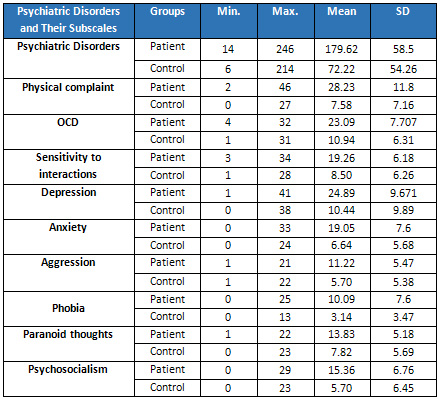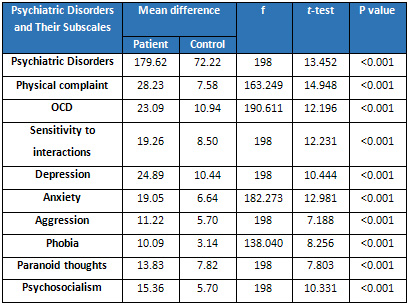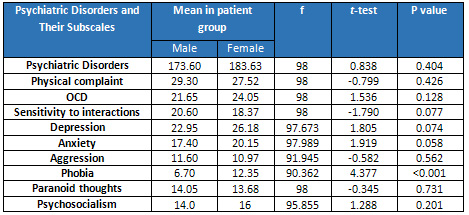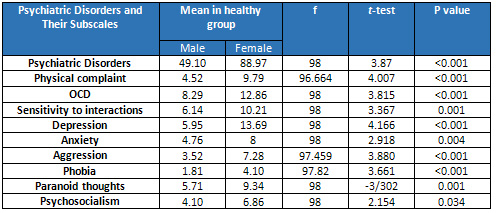|
|
 |
| ............................................................. |
|
|
| ........................................................ |
| From
the Editor |

|
Editorial
A. Abyad (Chief Editor) |
........................................................
|
|
Original contribution/Clinical Investigation
Diabetes Mellitus
- Knowledge, Management and Complications: Survey
report from Faisalabad-Pakistan
Ijaz Anwer, Ahmad Shahzad, Kashmira Nanji, Farah
Haider, Muhammad Masood Ahmad
Alanine aminotransferase
indicates excess weight and dyslipidemia
Mehmet Rami Helvaci, Orhan Ayyildiz* Mustafa
Cem Algin, Yusuf Aydin, Abdulrazak Abyad, Lesley
Pocock
Comparative Analysis of Antimicrobial Peptides
Gene Expression in Susceptible/Resistant Mice
Macrophages to Leishmania major Infection
Hamid Daneshvar, Iraj Sharifi, Alireza Kyhani,
Amir Tavakoli Kareshk, Arash Asadi
Does
socio-economic status of the patients have effect
on clinical outcomes after coronary artery bypass
grafting surgery?
Forough Razmjooei, Afshin Mansourian, Saeed
Kouhpyma
Comparison of the uterine
artery Doppler indices during pregnancy between
gestational diabetes and diabetes mellitus and
healthy pregnant women
Nazanin Farshchian, Farhad Naleini, Amir Masoud
Jaafarnejhad,
Parisa Bahrami Kamangar
Survey single dose
Gentamicin in treatment of UTI in children with
range of 1 month to 13 years old in Jahrom during
2015
Ehsan Rahmanian, Farideh Mogharab,
Vahid Mogharab
Evaluation of control of
bleeding by electro cauterization of bleeding
points of amplatz sheath tract after percutaneous
nephrolithotomy (PCNL) in Jahrom Peymanieh hospital
during year 2015-2016
Ali Reza Yousefi , Reza Inaloo
Comparison of the three-finger
tracheal palpation technique with triple ID
formula to determine endotracheal tube depth
in children 2-8 years in 2016-2017
Anahid Maleki, Alireza Ebrahim Soltani, Alireza
Takzare, Ebrahim Espahbodi,
Mehrdad Goodarzi , Roya Noori
Effect of Sevoflurane
and Propofol on pulmonary arterial pressure
during cardiac catheterization in children with
congenital heart diseases
Faranak Behnaz, Mahshid Ghasemi , Gholamreza
Mohseni, Azim Zaraki
Population and Community Studies
Prevalence
and risk factors of obesity in children aged
2-12 years in the Abu Dhabi Islands
Eideh Al-Shehhi, Hessa Al-Dhefairi, Kholoud
Abuasi, Noora Al Ali, Mona Al Tunaiji, Ebtihal
Darwish
Study and comparison
of psychological disorders in normal students
and students with multiple sclerosis in Shahrekord
Neda Ardestani-Samani, Mohammad Rabiei, Mohammad
Ghasemi-Pirbalooti, Asghar Bayati, Saeid Heidari-Soureshjani
Comparative
study of self-concept, physical self-concept,
and time perspective between the students with
multiple sclerosis and healthy students in Shahrekord
Neda Ardestani-Samani, Mohammad Rabiei, Mohammad
Ghasemi-Pirbalooti, Asghar Bayati, Saeid Heidari-Soureshjani
Relationship
between Coping Styles and Religious Orientation
with Mental Health in the Students of the Nursing-Midwifery
Faculty of Zabol
Nasim Dastras, Mohsen Heidari Mokarrar, Majid
Dastras, Shirzad Arianmehr
Tuberculosis in Abadan,
Iran (2012-2016): An Epidemiological Study
Ali-Asghar ValiPour, Azimeh Karimyan, Mahmood
Banarimehr, Marzieh Ghassemi, Maryam Robeyhavi,
Rahil Hojjati,
Parvin Gholizadeh
Family Stability and Conflict
of Spiritual Beliefs and Superstitions among
Yazdi People in Iran: A Qualitative Study
Zahra Pourmovahed , Seyed Saied Mazloomy Mahmoodabad
; Hassan Zareei Mahmoodabadi ; Hossein Tavangar
; Seyed Mojtaba Yassini Ardekani ; Ali Akbar
Vaezi
A comparative
study of the self-actualization in psychology
and Islam
Simin Afrasibi, Zakieh Fattahi
The effectiveness
of cognitive - behavioral therapy in reducing
the post-traumatic stress symptoms in male students
survivors of earthquake in the central district
of Varzeghan
Sakineh Salamat, Dr.Ahad Ahangar, Robab Farajzadeh
Reviews
Effects and mechanisms
of medicinal plants on stress hormone (cortisol):
A systematic review
Kamal Solati, Saeid Heidari-Soureshjani, Lesley
Pocock
Comparing Traditional
and medical treatments for constipation : A
Review Article
Mohammad Yaqub Rajput
A review of anti-measles
and anti-rubella antibodies in 15- 25 year old
women in Jahrom City in 2011
Ehsan Rahmania , Farideh Mogharab, Vahid Mogharab
Review of percutaneous
nephrolithotomy in children below 12 years old
in Jahrom hospital, during 2010-2014
Ali Reza Yousefi , Reza Inaloo
Physical and
mental health in Islam
Bahador Mehraki, Abdollah Gholami
International Health Affairs
The Challenges of Implementation
of Professional Ethics Standards in Clinical Care
from the viewpoint of Nursing Students and Nurses
Saeedeh Elhami, Kambiz Saberi, Maryam Ban, Sajedeh
Mousaviasl, Nasim Hatefi Moadab, Marzieh Ghassemi
Cognitive Determinants
of Physical Activity Intention among Iranian Nurses:
An Application of Integrative Model of Behavior
Prediction
Arsalan Ghaderi, Firoozeh Mostafavi, Behzad Mahaki,
Abdorrahim Afkhamzadeh,
Yadolah Zarezadeh , Erfan Sadeghi
Effect of resilience-based
intervention on occupational stress among nurses
Hossein Jafarizadeh, Ebrahim Zhiyani, Nader
Aghakhani, Vahid Alinejad, Yaser Moradi
Education and Training
Calculation of Salaries
and Benefits of Faculty Members in the Ministry
of Health and Medical Education of Iran
Abdolreza Gilavand
The effect of education
on self-care behaviors of gastrointestinal side
effects on patients undergoing chemotherapy
Shokoh Varaei, Ehsan Abadi Pishe, Shadan Pedram
Razie, Lila Nezam Abadi Farahani
Creating and
Validating the Faith Inventory for Students
at Islamic Azad University of Ahvaz
Solmaz Choheili, Reza Pasha, Gholam Hossein
Maktabi, Ehsan Moheb
Creating
and Validating the Adjustment Inventory for
the Students of Islamic Azad University of Ahvaz
Homa Choheili, Reza Pasha, Gholam Hossein Maktabi,
Ehsan Moheb
Evaluating
the Quality of Educational Services from the
Viewpoints of Radiology Students of Ahvaz Jundishapur
University of Medical Sciences
Abdolreza Gilavand, Jafar Fatahiasl
An Investigation
of Psychosocial aspect of Iranian Nursing Students'
Clinical Setting
Mahsa Boozaripour , Zanyar Karimi, Sima Zohari
Anbohi, Amir Almasi-Hashiani, Fariba Borhani
Clinical Research and Methods
Comparison of the
Antibacterial Effects of Chlorhexidine Mouth
washes with Jaftex Mouth wash on Some Common
Oral Microorganisms (An in Vitro Study)
Ebrahim Babadi, Zahra Bamzadeh, Fatemeh Babadi
Study of the effect
of plasma jet on Fusarium isolates with ability
to produce DON toxins
Elham Galin Abbasian, Mansour Bayat, Arash chaichi
Nosrati, Seyed Jamal Hashemi, Mahmood Ghoranneviss
The comparison of
anti-inflammatory effect in two methods of topical
dexamethasone injection and topical application
of ginger alcoholic extract after removing mandibular
wisdom teeth
Sahar Zandi, Seyyed Muhammadreza Alavi, Kamran
Mirzaie, Ramin Seyedian, Narges Aria, Saman
Jokar
The effect of curcumin
on growth and adherence of major microorganisms
causing tooth decay
Leila Helalat, Ahmad Zarejavid, Alireza Ekrami,
Mohammd Hosein Haghighizadeh, Mehdi Shiri Nasab
|
|
Chief
Editor -
Abdulrazak
Abyad
MD, MPH, MBA, AGSF, AFCHSE
.........................................................
Editorial
Office -
Abyad Medical Center & Middle East Longevity
Institute
Azmi Street, Abdo Center,
PO BOX 618
Tripoli, Lebanon
Phone: (961) 6-443684
Fax: (961) 6-443685
Email:
aabyad@cyberia.net.lb
.........................................................
Publisher
-
Lesley
Pocock
medi+WORLD International
11 Colston Avenue,
Sherbrooke 3789
AUSTRALIA
Phone: +61 (3) 9005 9847
Fax: +61 (3) 9012 5857
Email:
lesleypocock@mediworld.com.au
.........................................................
Editorial
Enquiries -
abyad@cyberia.net.lb
.........................................................
Advertising
Enquiries -
lesleypocock@mediworld.com.au
.........................................................
While all
efforts have been made to ensure the accuracy
of the information in this journal, opinions
expressed are those of the authors and do not
necessarily reflect the views of The Publishers,
Editor or the Editorial Board. The publishers,
Editor and Editorial Board cannot be held responsible
for errors or any consequences arising from
the use of information contained in this journal;
or the views and opinions expressed. Publication
of any advertisements does not constitute any
endorsement by the Publishers and Editors of
the product advertised.
The contents
of this journal are copyright. Apart from any
fair dealing for purposes of private study,
research, criticism or review, as permitted
under the Australian Copyright Act, no part
of this program may be reproduced without the
permission of the publisher.
|
|
|
| November 2017
- Volume 15, Issue 9 |
|
|
Study and comparison
of psychological disorders in normal students
and students with multiple sclerosis in Shahrekord
Neda Ardestani-Samani (1)
Mohammad Rabiei (2)
Mohammad Ghasemi-Pirbalooti (1)
Asghar Bayati (3)
Saeid Heidari-Soureshjani (3)
(1) Islamic Azad University, Shahrekord Branch,
Shahrekord, Iran;
(2) University of Shahrekord, Shahrekord, Iran;
(3) Shahrekord University of Medical Sciences,
Shahrekord, Iran.
Corresponding author:
Saeid Heidari-Soureshjani
Shahrekord University of Medical Sciences,
Kashani Blvd, Shahrekord,
Iran
Email: heidari_1983@yahoo.com
|
Abstract
Because
various diseases could predispose people
to psychiatric disorders that lead to
numerous individual and therefore social
problems, the aim of the present study
was to study the difference in psychiatric
disorders between students with multiple
sclerosis (MS) and healthy students. In
this prospective, causal-comparative type,
samples were students living in Shahrekord.
The number of participants, both male
and female, was 200 (100 patients with
MS and 100 healthy people); healthy participants
were enrolled by two-stage cluster sampling
and the people with MS by non-random convenience
sampling. Symptom Checklist-90-2 was used
to collect data and data analysis conducted
by SPSS 20. The mean scores on psychological
disorders and their dimensions were significantly
higher in patient group than healthy group
(p<0.05). In healthy group, psychological
disorders and their subscales were significantly
higher in women (P<0.05), and in patient
group, phobia was significantly higher
in women than men (P<0.05), but no
significant difference in the scores on
psychological disorders and theirsubscales
was seen between women and men in patient
group (P<0.05). MS could lead topsychiatric
disorders and morbidity in both women
and men.
Key words:
Multiple sclerosis, Psychological disorders,
Students, Shahrekord.
|
Multiple sclerosis (MS) is a chronic and progressive
disease of the central nervous system in which
the immune system demyelinates the nerves of
the brain and spinal cord and therefore nerve
signaling is slowed down. MS causes blurred
vision, dysplasia, muscle weakness, loss of
balance and coordination, sensation disturbance,
depression, moderate to severe pain, cognitive
impairment, forgetfulness, lack of concentration,
fatigue, tremor, dizziness, and bowel, bladder,
and sexual dysfunction. There is no definite
treatment for this disease (1,2). The exact
cause of MS is unknown but the most likely ones
are genetic, immunologic, and viral (3).
Obviously, mental health plays a significant
role in all life aspects including physical
health; because MS affects physical, psychological,
and social aspects of life adversely, it may
lead to several psychiatric disorders including
depression, anxiety, and high levels of stress
(4). However, this issue remains insufficiently
studied and the potentially involved factors
should be further investigated (4,5). Given
the significance of mental health and because
psychiatric disorders lead to declined individual
and family functioning and achievements, and
therefore disequilibrium of individual status,
illness, and dysfunction of the community (6,7),
we investigated the difference in psychiatric
disorders between students with MS and healthy
students.
The study population of this prospective, causal-comparative
study consisted of the students living in Shahrekord.
A total of 200 people, both male and female,
were enrolled. One hundred of participants had
MS and the rest were healthy. Healthy participants
were selected by convenience, two-stage cluster
sampling. For this purpose, city was divided
into 36 districts of which 12 were randomly
selected. Then, systematic sampling was conducted
in each district. More specifically speaking,
every 10th house was chosen after a house was
randomly selected as starting point (no. 1),
and then the following selected houses were
11, 21, 31, 41, etc. Questionnaires were completed
by one of the household members who were studying
at university. Besides that, the samples with
MS were selected by nonrandom convenience sampling.
Briefly, we referred to the the Multiple Sclerosis
Association of Shahrekord, and asked the eligible
patients who were present there to complete
questionnaires. Symptom Checklist (SCL)-90-2
was used to measure psychiatric disorders. SCL-90-2
is one of the most frequently used scales for
diagnosing psychiatric disorders in the USA.
This scale, first developed to investigate
the psychological aspects of physical and mental
patients, consists of 90 items to evaluate psychological
problems. This scale can also be used to differentiate
healthy people from patients (8). The subscales
of the SCL-90-2 are physical complaint, obsessive-compulsive
disorder (OCD), sensitivity to interactions,
depression, anxiety, aggression, anxiety, paranoid
thoughts, and psychosocialism collectively representing
the score on psychiatric disorders. The items
are rated on a 5-point (0-4) Likert scale. To
calculate the score on psychiatric disorder
and each subscale, each subscale is first summed
and then divided by its respective number of
items to obtain a mean score. The mean scores
1 represent morbidity and those > 3 do psychosocialism.
A study to investigate the validity and reliability
of the SCL-90-2 for Iranian population, has
reported that both the subscales and the global
severity index of this scale have high internal
consistency (Cronbach’s alpha coefficients:
0.75-0.92 and 0.98, respectively) (9).
Data were analyzed by descriptive statistics
(mean, standard deviation, maximum, and minimum)
and analytical statistics (independent t-test)
in SPSS 20.
Overall,
59%
of
the
participants
were
female.
The
mean
age
of
the
participants
was
approximately
25
years
(standard
deviation:
3.750,
range:
19-35
years).
Eighty
one
percent
of
the
participants
were
associate’s
and
bachelor’s
degree
students
and
the
rest
master’s
degree
students.
Table
1
shows
the
descriptive
data
on
psychiatric
disorders
and
their
subscales.
In
patient
group,
the
mean
scores
on
physical
complaint
and
phobia
were
the
highest
and
lowest
scores,
respectively;
in
healthy
group,
the
mean
scores
on
paranoid
thoughts
and
phobia
were
the
highest
and
lowest
scores,
respectively.
The
mean
scores
on
psychiatric
disorders
and
all
of
their
subscales
were
higher
in
the
participants
with
MS
than
healthy
participants,
and
therefore,
the
morbidity
associated
with
psychiatric
disorders
and
all
of
subscales
was
seen
in
patient
group.
Besides
that,
in
healthy
group
paranoid
thoughts
and
OCD
were
seen
but
psychiatric
disorders,
their
subscales,
and
associated
morbidity
were
not
seen
(Table
1).
Table
1:
Central
indices
and
distribution
of
the
scores
on
psychiatric
disorders
and
their
subscales
in
healthy
people
and
patients
with
multiple
sclerosis

Independent
t-test
was
used
to
investigate
the
difference
in
psychiatric
disorders
and
their
subscales
between
patient
group
and
healthy
group.
There
were
significant
differences
in
the
mean
scores
on
psychiatric
disorders
and
their
subscales
between
patient
and
healthy
groups
(p<0.05)
(Table
2).
Table
2:
T-test
results
on
the
differences
in
psychiatric
disorders
and
their
subscales
between
healthy
people
and
patients
with
multiple
sclerosis

Therefore,
psychiatric
disorders
and
their
subscales
(physical
complaint,
OCD,
sensitivity
to
interactions,
depression,
anxiety,
aggression,
anxiety,
paranoid
thoughts,
and
psychosocialism)
were
higher
in
patient
group
than
healthy
group
(Table
1).
In
addition,
t-test
was
used
to
investigate
differences
in
psychiatric
disorders
and
their
subscales
between
males
and
females.
Results
demonstrated
that
in
patient
group,
the
mean
scores
on
psychiatric
disorders
and
the
subscales
OCD,
depression,
anxiety,
and
psychosocialism
were
higher
in
females
than
males;
and
the
mean
scores
on
the
subscales
physical
complaint,
sensitivity
to
interactions,
aggression,
and
paranoid
thoughts
were
insignificantly
higher
in
males
than
females
(p>0.05).
But
mean
phobia
score
was
significantly
higher
in
females
than
males.
(Table
3).
In
healthy
group,
the
mean
scores
on
psychiatric
disorders
and
all
of
their
subscales
were
significantly
higher
in
females
than
males
(p>0.05)
(Table
4).
Table
3:
T-test
results
on
the
differences
in
psychiatric
disorders
and
their
subscales
between
males
and
females
in
patient
group

Table
4:
T-test
results
on
the
difference
in
psychiatric
disorders
and
their
subscales
between
males
and
females
in
healthy
group

This
study
was
conducted
to
comparatively
investigate
psychiatric
disorders
and
all
of
their
subscales
(physical
complaint,
OCD,
sensitivity
to
interactions,
depression,
anxiety,
aggression,
phobia,
paranoid
thoughts,
and
psychosocialism)
in
the
students
with
MS
and
healthy
students
in
Shahrekord,
Results
showed
the
morbidity
associated
with
psychiatric
disorders
and
all
of
its
subscales
were
present
in
MS
patients.
In
healthy
group,
paranoid
thoughts
and
OCD
were
seen
but
psychiatric
disorders
and
other
subscales
of
them
were
not
seen.
Results
also
indicated
that
the
mean
scores
on
psychiatric
disorders
and
all
of
their
subscales
were
significantly
higher
in
the
participants
with
MS
than
healthy
participants.
This
finding
indicates
that
psychiatric
disorders
and
their
subscales
(physical
complaint,
OCD,
sensitivity
to
interactions,
depression,
anxiety,
aggression,
phobia,
paranoid
thoughts,
and
psychosocialism)
are
higher
in
the
people
with
MS
than
healthy
people.
A
study
has
shown
that
patients
with
MS
are
likely
to
develop
certain
disorders
such
as
depression,
anxiety,
neuroticism,
and
impaired
memory
and
concentration
(10).
Feinstein
reported
that
only
28%
of
the
patients
were
not
diagnosed
with
psychiatric
disorders,
and
these
disorders
were
associated
with
neurological
disorders
and
other
aspects
of
MS
(11).
A
study
showed
that
MS
patients’
quality
of
life
was
significantly
and
directly
correlated
with
neurological
disability
and
SCL-90-R
score,
and
mental
distress
significantly
declined
quality
of
life
(12).
Hall
et
al.
studied
the
relationship
between
cognitive
functions,
somatization,
and
behavioural
coping
in
patients
with
multiple
functional
somatic
symptoms,
and
observed
that
the
physical
symptoms
influenced
memory
and
psychological
and
behavioral
symptoms.
Therefore,
our
study
is
consistent
with
the
findings
of
Hall
et
al.
regarding
higher
psychiatric
disorders
in
the
people
with
physical
diseases
and
problems.
Evidence
on
the
comparison
of
psychiatric
disorders
between
MS
patients
and
healthy
people
is
scant,
which
highlights
a
strength
of
the
current
study.
Another
study
has
shown
that
the
psychiatric
disorders
are
predictors
of
other
psychiatric
disorders
and
even
influence
treatment
course
in
the
MS
patients
(14).
Certain
psychiatric
disorders
in
MS
patients
may
be
disregarded
and
be
influenced
by
the
main
treatment.
They
may,
therefore,
be
left
untreated
(11).
This
issue
should
be
taken
into
special
consideration.
In
addition,
in
patient
group,
phobia
was
significantly
higher
in
females
than
males.
Studies
have
shown
that
psychiatric
disorders
including
anxiety
are
higher
in
women
(15-17).
It
can
be
argued
that
if
the
women
with
MS
are
left
unsupported
by
men,
their
socioeconomic
status
is
jeopardized,
and
they
are
therefore
more
predisposed
to
phobia.
However,
the
scores
on
psychiatric
disorders
and
other
subscales
were
not
significantly
different
between
males
and
females.
In
healthy
group,
psychiatric
disorders
and
all
of
their
subscales
were
significantly
higher
in
females
than
males,
which
is
consistent
with
other
findings
(15-17).
Development
of
MS
can
lead
to
psychiatric
disorders,
and
because
MS
causes
psychiatric
disorders
and
their
subscales,
as
morbidity,
to
increase,
then
organizations
such
as
the
Ministry
of
Health,
media,
and
the
Multiple
Sclerosis
Association
should
take
appropriate
measures
to
decrease
the
psychiatric
disorders
in
MS
patients
to
help
them
cope
better
with
MS.
Acknowledgment
This
study
has
been
found
by
Islamic
Azad
University,
Shahrekord
Branch,
Iran.
The
authors
thank
to
all
whom
cooperate
in
fulfilling
this
study.
1.
Johnston
Jr
RB,
Joy
JE.
Multiple
sclerosis:
current
status
and
strategies
for
the
future:
National
Academies
Press;
2001.
2.
Goldenberg
MM.
Multiple
Sclerosis
Review.
Pharmacy
and
Therapeutics.
2012;37(3):175-84.
3.
Libbey
JE,
Fujinami
RS.
Potential
Triggers
of
MS.
Results
and
problems
in
cell
differentiation.
2010;51:21-42.
4.
Chwastiak
LA,
Ehde
DM.
Psychiatric
Issues
in
Multiple
Sclerosis.
The
Psychiatric
clinics
of
North
America.
2007;30(4):803-17.
5.
Haussleiter
IS,
Brüne
M,
Juckel
G.
Psychopathology
in
Multiple
Sclerosis:
Diagnosis,
Prevalence
and
Treatment.
Therapeutic
Advances
in
Neurological
Disorders.
2009;2(1):13-29.
6.
Health
NIo.
NIH
Curriculum
Supplement
Series
[Internet].
Understanding
Emerging
and
Re-emerging
Infectious
Diseases.
2007.
7.
Sartorius
N.
Stigmatized
Illnesses
and
Health
Care.
Croatian
medical
journal.
2007;48(3):396-7.
8.
Dag
I.
Reliability
and
validity
of
Symptom
Check
List-90-Revised
among
university
students.
Türk
Psikiyatri
Derg.
1991;2(1):5-12.
9.
Anisi
J,
Eskandari
M,
Bahmanabadi
S,
Noohi
S,
Tavalayi
A.
Standardization
of
Symptom
Checklist
90
Revised
(SCL-90
-R)
of
a
military
Unit.
Journal
of
military
Psychology.
2014;5(17):57-67.
10.
Bruce
JM,
Hancock
LM,
Arnett
P,
Lynch
S.
Treatment
adherence
in
multiple
sclerosis:
association
with
emotional
status,
personality,
and
cognition.
Journal
of
Behavioral
Medicine.
2010;33(3):219-27.
11.
Feinstein
A.
Multiple
sclerosis
and
depression.
Multiple
Sclerosis
Journal.
2011;17(11):1276-81.
12.
Kern
S,
Schrempf
W,
Schneider
H,
Schultheiss
T,
Reichmann
H,
Ziemssen
T.
Neurological
disability,
psychological
distress,
and
health-related
quality
of
life
in
MS
patients
within
the
first
three
years
after
diagnosis.
Multiple
Sclerosis
Journal.
2009;15(6):752-8.
13.
Hall
NM,
Kuzminskyte
R,
Pedersen
AD,
Ørnbøl
E,
Fink
P.
The
relationship
between
cognitive
functions,
somatization
and
behavioural
coping
in
patients
with
multiple
functional
somatic
symptoms.
Nordic
journal
of
psychiatry.
2011;65(3):216-24.
14.
Brown
R,
Valpiani
EM,
Tennant
C,
Dunn
SM,
Sharrock
M,
Hodgkinson
S,
et
al.
Longitudinal
assessment
of
anxiety,
depression,
and
fatigue
in
people
with
multiple
sclerosis.
Psychology
and
Psychotherapy:
Theory,
Research
and
Practice.
2009;82(1):41-56.
15.
Giordano
A,
Granella
F,
Lugaresi
A,
Martinelli
V,
Trojano
M,
Confalonieri
P,
et
al.
Anxiety
and
depression
in
multiple
sclerosis
patients
around
diagnosis.
Journal
of
the
Neurological
Sciences.
2011;307(1):86-91.
16.
Nguyen
C,
Bérezné
A,
Baubet
T,
Mestre-Stanislas
C,
Rannou
F,
Papelard
A,
et
al.
Association
of
gender
with
clinical
expression,
quality
of
life,
disability,
and
depression
and
anxiety
in
patients
with
systemic
sclerosis.
PLoS
One.
2011;6(3):e17551.
17.
Dahl
O-P,
Stordal
E,
Lydersen
S,
Midgard
R.
Anxiety
and
depression
in
multiple
sclerosis.
A
comparative
population-based
study
in
Nord-Trøndelag
County,
Norway.
Multiple
Sclerosis
Journal.
2009;15(12):1495-501.
|
|
.................................................................................................................

|
| |
|

